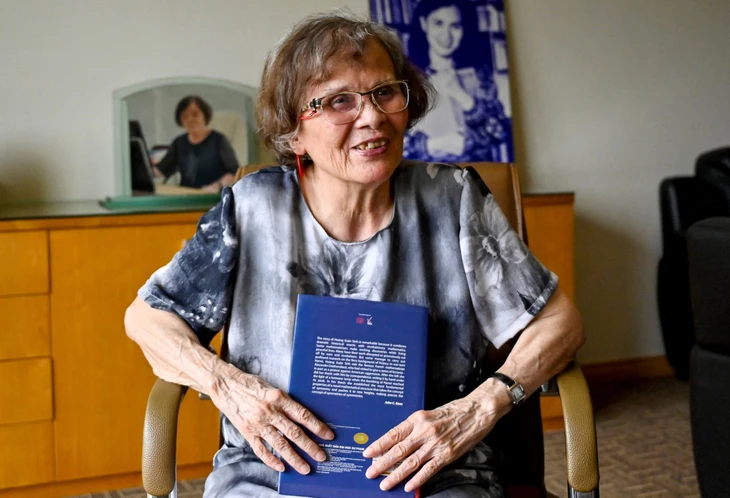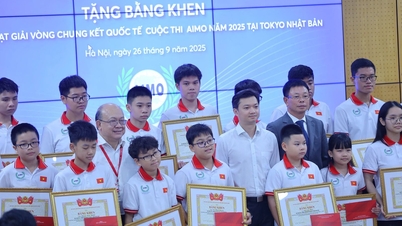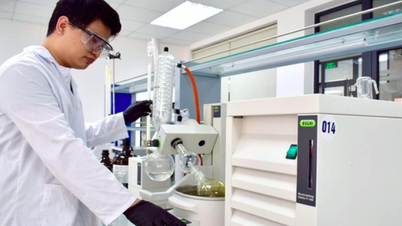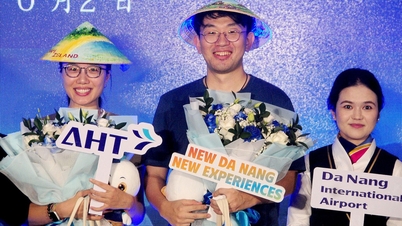Mathematics professor Hoang Xuan Sinh holds her doctoral thesis written from the hardships and deprivations of wartime, at her office at Thang Long University, Hanoi - Photo: AFP
In December 1972, when the US Air Force's B-52 bombers were massively bombing Hanoi and surrounding areas in the Christmas Eve bombing campaign (or the " Dien Bien Phu in the Air" campaign, from December 18 to 29, 1972), Professor Hoang Xuan Sinh was still diligently working on his handwritten thesis in the flickering light of a kerosene lamp.
“We narrowly escaped death,” Ms. Sinh, 91, told AFP, her voice trembling as she recalled the nights when Hanoi was rained with bombs in late 1972. At that time, about 20,000 tons of bombs were dropped on the northern region for 12 consecutive days and nights.
Born in 1933 in Hanoi during the resistance war against France and growing up during the resistance war against the US, Ms. Sinh's life partly reflects the modern history of Vietnam, according to AFP.
Fateful meeting with a French mathematician
In an interview with AFP, Ms. Sinh recounted fluently in French her fateful meeting with the French "genius" mathematician Alexander Grothendieck.
Mr. Grothendieck is one of the most important figures in the world of mathematics of the 20th century. He is considered to have “revolutionized” mathematics in the way that genius Albert Einstein did with Physics and is known as the “Einstein of mathematics”.
In 1967, Ms. Sinh met Grothendieck when he was teaching algebra to students and lecturers in the North.
Despite the constant threat of bombs and bullets, the French mathematician stayed in the S-shaped land for nearly a month, believing he had to stand side by side with scholars and colleagues who were striving to study and research in harsh conditions.
“He was a very good teacher. He knew how to turn complicated things into surprisingly simple things,” Ms. Sinh recalled of her teacher from France.
At that time, Hanoi Pedagogical University was dispersed in many rural villages to avoid bombing. Mr. Grothendieck, Ms. Sinh and the students lived with farmers' families, without electricity or running water.
“The house was small but they still reserved a corner for us, just enough to put a desk,” Ms. Sinh smiled as she recalled.
After proposing a thesis topic and receiving Grothendieck's approval, she and he began the eight-year journey of writing the thesis without a library or typewriter.
When Grothendieck left Vietnam, he sent back two brief letters of instructions.
Handwritten thesis in bomb smoke
During the day she teaches, at night Mrs. Sinh quietly writes her thesis by oil lamp light.
At that time, she always wished to have a flashlight so she could study under a mosquito net because at that time there were only kerosene lamps - a type of lamp that could easily cause fire.
The thesis was completed at the end of 1972, in the midst of the "rain of B-52 bombs", but it was not until May 1975, after the country's reunification, that she successfully defended her thesis at Paris Diderot University (France).
In particular, thanks to Mr. Grothendieck's intervention, the school accepted her handwritten thesis. Perhaps, this is also the first doctoral thesis written entirely by hand that the school received.
“Writing paper, something that seemed normal, became a luxury amid the bombardment,” she smiled lightly as she recalled a difficult time.
The thesis board also included famous mathematician Laurent Schwartz, who won the Fields Medal - the most prestigious award in mathematics.
Today, in the hallway of Thang Long University - which she founded in 1988, portraits of the two mathematicians Grothendieck and Schwartz are still hung solemnly.
Once a week, she returns to visit the school, feed the pigeons and walk around the campus filled with memories...
UYEN PHUONG
Source: https://tuoitre.vn/cuoc-gap-dinh-menh-giua-giao-su-hoang-xuan-sinh-va-thien-tai-toan-hoc-alexander-grothendi-20250523180547718.htm





![[Photo] Binh Trieu 1 Bridge has been completed, raised by 1.1m, and will open to traffic at the end of November.](https://vphoto.vietnam.vn/thumb/1200x675/vietnam/resource/IMAGE/2025/10/2/a6549e2a3b5848a1ba76a1ded6141fae)



























































































Comment (0)